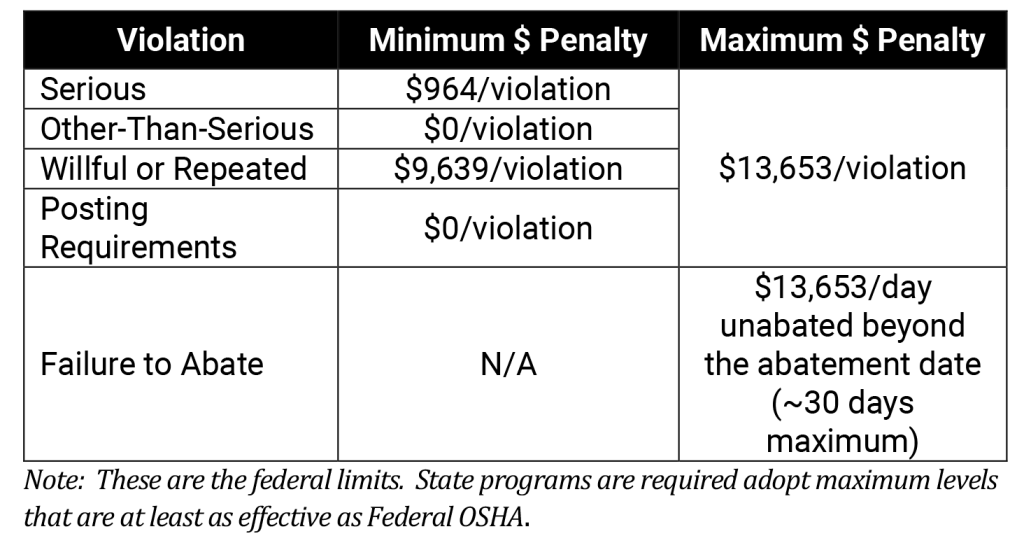OSHA has raised its maximum and minimum penalty dollar amounts with a cost of living adjustment. These new rates go into effect January 15, 2021:

There are maximum and minimum amounts, but most fall somewhere in between. So how are OSHA fines calculated?
The Violation Categories
Serious violations are considered high, medium or low severity. Other-Than-Serious violations are minimal severity.
Willful violations are cited when employers knowingly fail to comply or when they act with indifference to employee safety.
Repeated violations occur when an employer has been previously cited for the same or substantially similar condition. For serious violations, these are ones that have been a part of OSHA’s regionwide inspection history where an OSHA Notice was issued within the past 5 years. For other-than-serious violations, it’s for those where the establishment being inspected received an OSHA Notice within the past 5 years.
The Posting Requirements violation is issued when you fail to follow through on your requirement to post your OSHA Notice at or near the place where each violation occurred for 3 working days, or until the hazard is abated (whichever is longer).
Failure to Abate violations occur when you receive a Notice of Unsafe or Unhealthful Working Conditions and a follow-up inspection finds that you did not do your required posting, did not correct the violation and/or did not adequately protect employees and make appropriate progress in correcting the hazard before the abatement date that was listed on your notice.
Calculating Violation Amounts
There are a number of factors that actually can determine how much your penalty will be. There are four major categories of factors that go into the calculation:
- Gravity of violation
- History of violations
- Good faith efforts of the employer
- Business size
Gravity Based Penalty Amounts
First, the gravity of the violation is calculated. The Gravity Based Penalty (GBP) Amount looks at the level of severity (low, medium and high) and the probability, that is likelihood an injury or illness will occur (greater or lesser).
Severity + Probability = Gravity Based Penalty Amount
Here are the Gravity Based Penalty Amounts for 2021:

History Reductions
Combined or grouped violations can be considered one citation item. Multiple violations of the same standard can also be combined into one citation item. Expect the one with the highest gravity factor (severity or probability) to be used to determine the GBP.
A 10% reduction in penalty costs can be given to companies who have been inspected by OSHA and have had no serious, willful, repeat or failure-to-abate violations. If your company hasn’t been inspected within 5 years, you’re not eligible for this discount. If you’ve had a serious high gravity citation that became a final order, you could actually see a 10% increase in your costs.
Good Faith Reductions
A maximum discount of 25% can be given for good faith efforts. The maximum 25% discount requires you to have a written health and safety management system. This would include a system outlining:
- Management commitment and employee involvement
- Hazard identification worksite analyses
- Hazard prevention and control measures
- Safety and health training
- Addressing needs of workers less than 18 years old (if applicable)
- Addressing needs of workers who speak limited or no English (if applicable)
A 15% reduction may be given if the employer has a documented and effective safety and health management system with only incidental deficiencies.
Good faith discounts will NOT be given for high gravity, willful, repeated, and failure to abate violations, or if you’ve reported a fatality, inpatient hospitalization, amputation or an eye loss.
Business Size Reductions
A maximum 70% reduction can be gained based on your company size. OSHA wanted to create a scale where they could minimize the impact to small businesses. This reduction applies to businesses with 250 or less employees total nationwide. Companies with 1-10 employees can get the 70% reduction, 11-25 employees a 60% reduction, 26-100 is 30%, and 101-250 is 10%.
Quick Fix Reductions
If you’re able to make an immediate correction to an individual violation and that correction is 1) permanent or substantial (e.g., not just moving someone out of the way), 2) not blatantly obvious (e.g., wearing a hard hat or safety glasses), and 3) not a high gravity serious/willful/repeat/failure to abate violation, you can get a 15% Quick Fix reduction. This one is applied after the good faith and history adjustments are made.
Limits of Discounts
Different discounts can be rescinded or altered depending on the circumstance or type of violation.
Repeated violations will only be reduced for size. Repeated violations can actually have their penalties increased, and those increases are also based on size.
Willful violations are only eligible for a size and history discount. Willful violations have their own size chart of reduction percentages.
Serious violations classified as higher severity/greater probability are only eligible for the size and history.
Other Penalties
OSHA has additional calculation guidelines for a number of other circumstances including:
- Unabated violations;
- Daily penalty multipliers;
- Partial abatements;
- Violation-by-violation egregious penalties;
- Multi-employer worksites;
- Federal Agency significant cases;
- Failure to post citations;
- Failure to notify authorized employees of an advance notice of inspection;
- Injury and illness reporting and recordkeeping;
- Failure to provide access to medical and exposure records;
- Failure to notify and tag; and,
- Failing to certify abatement.
You can find all of the details about these penalties and reductions in OSHA’s Field Operations Manual section on penalties.
2021 adjustments and rates can be found in OSHA’s Enforcement Memo dated January 8, 2021.
If you find yourself needing help sorting these out, or if you’d like to get started on a safety and health management system to get started on a potential good faith discount, contact us!
Safety Management Programs
You can score deductions with a safety and health management system. We can help you develop one, or at least help with the pieces.